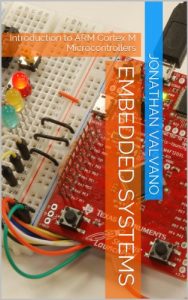Embedded systems are a ubiquitous component of our everyday lives. We interact with hundreds of tiny computers every day that are embedded into our houses, our cars, our toys, and our work. As our world has become more complex, so have the capabilities of the microcontrollers embedded into our devices. The ARM Cortex-M family represents a new class of microcontrollers much more powerful than the devices available ten years ago. The purpose of this book is to present the design methodology to train young engineers to understand the basic building blocks that comprise devices like a cell phone, an MP3 player, a pacemaker, antilock brakes, and an engine controller.
This book, now in its 5th edition, is the first in a series of three books that teach the fundamentals of embedded systems as applied to the ARM Cortex-M family of microcontrollers. This first book is an introduction to computers and interfacing focusing on assembly language and C programming. The second book Embedded Systems: Real-Time Interfacing to ARM Cortex-M Microcontrollers focuses on hardware/software interfacing and the design of embedded systems. The third book Embedded Systems: Real-Time Operating Systems for ARM Cortex-M Microcontrollers is an advanced book focusing on operating systems, high-speed interfacing, control systems, and robotics. The third volume could also be used for professionals wishing to design or deploy a real-time operating system onto an ARM platform. This first book is an introductory book that could be used at the college level with little or no prerequisites.
An embedded system is a system that performs a specific task and has a computer embedded inside. A system is comprised of components and interfaces connected together for a common purpose. This book is an introduction to embedded systems. Specific topics include microcontrollers, fixed-point numbers, the design of software in assembly language and C, elementary data structures, programming input/output including interrupts, analog to digital conversion, digital to analog conversion.
The book will cover embedded systems for ARM Cortex-M microcontrollers with specific details on the TM4C123, and TM4C1294. Most of the topics can be run on any of these microcontrollers. Although the solutions are specific for the TM4C family, it will be possible to use these books for other ARM derivatives.
The true engineering experience occurs not with your eyes and ears, but rather with your fingers and elbows. In other words, engineering education does not happen by listening in class or reading a book; rather it happens by designing under the watchful eyes of a patient mentor. So, go build something today, then show it to someone you respect!
This book, now in its 5th edition, is the first in a series of three books that teach the fundamentals of embedded systems as applied to the ARM Cortex-M family of microcontrollers. This first book is an introduction to computers and interfacing focusing on assembly language and C programming. The second book Embedded Systems: Real-Time Interfacing to ARM Cortex-M Microcontrollers focuses on hardware/software interfacing and the design of embedded systems. The third book Embedded Systems: Real-Time Operating Systems for ARM Cortex-M Microcontrollers is an advanced book focusing on operating systems, high-speed interfacing, control systems, and robotics. The third volume could also be used for professionals wishing to design or deploy a real-time operating system onto an ARM platform. This first book is an introductory book that could be used at the college level with little or no prerequisites.
An embedded system is a system that performs a specific task and has a computer embedded inside. A system is comprised of components and interfaces connected together for a common purpose. This book is an introduction to embedded systems. Specific topics include microcontrollers, fixed-point numbers, the design of software in assembly language and C, elementary data structures, programming input/output including interrupts, analog to digital conversion, digital to analog conversion.
The book will cover embedded systems for ARM Cortex-M microcontrollers with specific details on the TM4C123, and TM4C1294. Most of the topics can be run on any of these microcontrollers. Although the solutions are specific for the TM4C family, it will be possible to use these books for other ARM derivatives.
The true engineering experience occurs not with your eyes and ears, but rather with your fingers and elbows. In other words, engineering education does not happen by listening in class or reading a book; rather it happens by designing under the watchful eyes of a patient mentor. So, go build something today, then show it to someone you respect!






